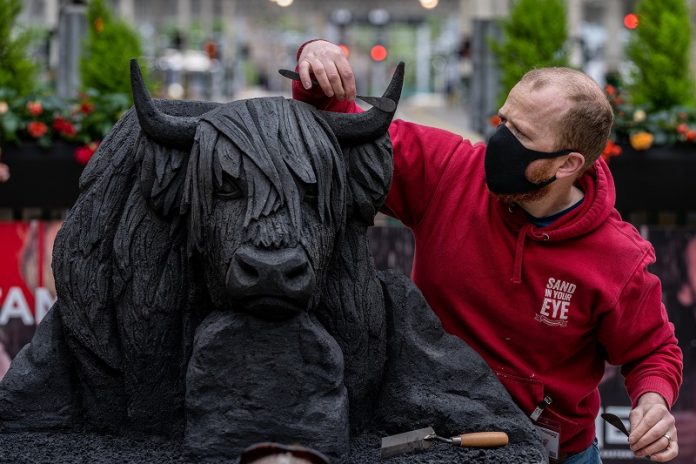
Those from Scotland tipped to travel the length of the UK 6.8 times over the next year for domestic leisure purposes
- People travelling from Scotland will cover 1,432 miles by train, 1,335 miles by car and 1,360 miles by plane across the UK for leisure this year, adding up to emit 992kg of carbon
- Research by train operator London North Eastern Railway (LNER) identified the hidden carbon costs of driving to your staycation – with the average trip per passenger from Edinburgh to London via car having a carbon footprint of 73.83kg vs just 23.50kg by train
- Prioritising the climate, over half of Scots (53%) say they want to adopt greener travel habits post-pandemic and 63% plan to swap travelling by car or plane to their favourite UK holiday hotspot to train instead
- LNER launches campaign to help Brits travel greener with new downloadable ‘Green Guide’ – featuring environmentally friendly tourist tips for Edinburgh so both existing residents and visitors can plan their trip in the most sustainable way
13TH June 2021: New research has revealed that as a country, Scotland will travel 4,127 miles over the next year reuniting with family and friends and visiting holiday hotspots across the country – the equivalent of travelling the length of the entire UK 6.8 times.
After a year of lockdown, the average person from the region is tipped to travel 1,335 miles by car, 1,432 miles by train and 1,360 miles by plane for leisure and in pursuit of the perfect staycation, new research from train operator London North Eastern Railway (LNER) has found.
And all this travel adds up, with the average Scottish person set to contribute 992kg of carbon through domestic travel – with 60 per cent coming solely from domestic flights, the equivalent to 593 kgs. A further 298 kgs of carbon comes via car and 101kgs via train.
However, with record numbers of people planning on staycationing due to the pandemic, over half (53 percent) say they want to opt for greener travel and 63 per cent aim to swap at least one trip they would usually do by car to the train instead in the future. And if over the next year, Scots substituted just half of their planned leisure car and plane journeys within the UK to train, they’d reduce their carbon emissions by a staggering 349kg.
The study showed that over a half of those from Scotland (58 per cent) would like to reduce their carbon footprint, but 56 per cent find calculating their carbon footprint baffling, and 40 per cent aren’t sure how they would reduce it.
In response, LNER has launched a campaign to help people travel greener, including a free downloadable tourist guide on how to stay green in Edinburgh.
The train operator has also worked with artist Jamie Wardley to create a series of sculptures made out of black sand, with the relative weights and sizes of each sculpture reflecting the carbon emissions dumped into the atmosphere when travelling between London and Edinburgh via different modes of transport including train, car and plane. With Edinburgh playing host to an intricately designed cow!
Wardley spent over 100 hours creating the series of sculptures to highlight the environmental credentials of train travel, which emits six times less emissions into the atmosphere than air travel.
The research also found millennials were more likely to opt for more eco-friendly methods of transport, with almost three-quarters (72 per cent) of 18–34-year-olds choosing to travel by train for their UK holidays this year, whilst over 50s would prefer to celebrate their new-found freedom travelling by car or plane (77 per cent) rather than train for their much-earned break.
To help travellers make as little environmental impact as possible when stay-cationing as restrictions lift, the ‘Green Guide’ offers travellers eco-friendly choices, showcasing the best places to stay, eat and play during trips to Edinburgh – revealing local hotspots and even some hidden gems. Contributions are included from LNER staff and passengers and VisitScotland, and the ‘Green Guide’ can be downloaded for free here www.lner.co.uk/greenguides
Meanwhile, in its stations at these three destinations, the sculptures created by Wardley will be on display to the public for a week in Edinburgh Waverly starting on 12th June 2021.
David Horne, Managing Director of LNER, said: “While the past year has been difficult, there’s been great movement in everybody taking time to consider their own impact on the environment and seeking ways to make a positive change.
Adopting greener travel habits is something all of us can strive towards, and these sculptures are a fantastic visual representation of how the train is one of the most sustainable ways to travel, especially in relation to cars and planes.
As normality resumes, travel increases and carbon emissions inevitably rise, we hope to inspire people across the nation to consider taking the train to reduce their carbon footprint, and collectively we can make a real difference. Our Green Guide also offers some fantastic tips to explore the sights key UK cities have to offer, the eco-friendly way.”


